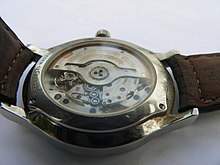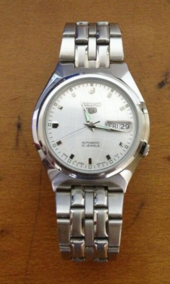Automatic watches
A self-winding or automatic watch is one that rewinds the mainspring of a mechanical movement by the natural motions of the wearer's body. The first self-winding mechanism was invented for pocket watches in 1770 by Abraham-Louis Perrelet,but the first "self-winding", or "automatic", wristwatch was the invention of a British watch repairer named John Harwood in 1923. This type of watch winds itself without requiring any special action by the wearer. It uses an eccentric weight, called a winding rotor, which rotates with the movement of the wearer's wrist. The back-and-forth motion of the winding rotor couples to a ratchet to wind the mainspring automatically. Self-winding watches usually can also be wound manually to keep them running when not worn or if the wearer's wrist motions are inadequate to keep the watch wound.

In April 2014 the Swatch Group launched the sistem51 wristwatch. It has a purely mechanical movement consisting of only 51 parts, including a novel self-winding mechanism with a transparent oscillating weight. So far, it is the only mechanical movement manufactured entirely on a fully automated assembly line.The low parts count and the automated assembly make it an inexpensive mechanical Swiss watch, which can be considered a successor to Roskopf movements, although of higher quality.

Electronic movements, also known as quartz movements, have few or no moving parts, except a quartz crystal which is made to vibrate by the piezoelectric effect. A varying electric voltage is applied to the crystal, which responds by changing its shape so, in combination with some electronic components, it functions as an oscillator. It resonates at a specific highly stable frequency, which is used to accurately pace a timekeeping mechanism. Most quartz movements are primarily electronic but are geared to drive mechanical hands on the face of the watch to provide a traditional analog display of the time, a feature most consumers still prefer.
In 1959 Seiko placed an order with Epson (a daughter company of Seiko and the 'brain' behind the quartz revolution) to start developing a quartz wristwatch. The project was codenamed 59A. By the 1964 Tokyo Summer Olympics, Seiko had a working prototype of a portable quartz watch which was used as the time measurements throughout the event.
The first prototypes of an electronic quartz wristwatch (not just portable quartz watches as the Seiko timekeeping devices at the Tokyo Olympics in 1964) were made by the CEH research laboratory in Neuchâtel, Switzerland. From 1965 through 1967 pioneering development work was done on a miniaturized 8192 Hz quartz oscillator, a thermo-compensation module, and an in-house-made, dedicated integrated circuit (unlike the hybrid circuits used in the later Seiko Astron wristwatch). As a result, the BETA 1 prototype set new timekeeping performance records at the International Chronometric Competition held at the Observatory of Neuchâtel in 1967.In 1970, 18 manufacturers exhibited production versions of the beta 21 wristwatch, including the Omega Electroquartz as well as Patek Philippe, Rolex Oysterquartz and Piaget.
Comments
Post a Comment